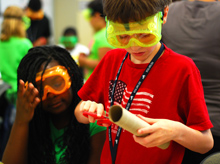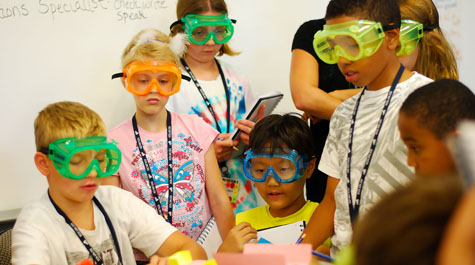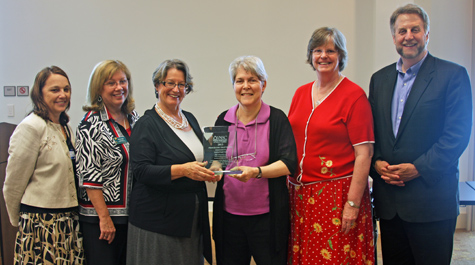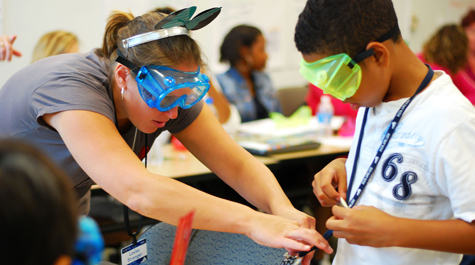VISTA brings problem-based approach to science learning
Program receives award from Virginia Mathematics and Science Coalition
Teach a child about fish, and she may learn for a day.
Ask a child to design a “fish ladder” to help the spawning creatures scale an energy-producing dam built to power a Disney theme park, and she may develop an interest in science that will last a lifetime.
That, at least, is the hope behind the Virginia Initiative for Science Teaching and Achievement (VISTA), a program that teaches teachers how to incorporate problem-based, hands-on learning into their science lessons. On Friday, William & Mary received an award from the Virginia Mathematics and Science Coalition (VMSC) for its VISTA efforts. The award was presented by Donna Sterling, professor of science education at George Mason University and the VISTA principal investigator, on behalf of the VMSC, to Education Dean Spencer Niles and the faculty and staff of the William & Mary VISTA project.
Friday’s award presentation came at the end of a two-week VISTA summer camp for students that took place at William & Mary’s School of Education. The camp was part of a four-week VISTA institute for 40 teachers from across the Tidewater area.
{{youtube:medium:left|I0-72LMJjnk, VISTA: A problem-based learning lab}}
“The point of what we’re doing is to give the teachers experience in planning and teaching science in a way that is connected to real-world problems and provides opportunities for creativity and ingenuity on the part of the kids, along with incorporating all of the Standards of Learning,” said Juanita Jo Matkins, VISTA co-principal investigator and associate professor of science education at William & Mary.
The institute at William & Mary began in late June with a six-day course for teachers in which they were asked to create plans for a summer camp that included hands-on science problems for students to solve. Next, a group of high-needs elementary school students from local schools arrived for a 10-day summer science camp during which the teachers put their plans into action, asking students to tackle problems surrounding energy production, extraction and use.
In one of the camps, the students were asked to help Disney explore the possibility of putting an environmentally-friendly theme park in Virginia. One of the tasks that the children were asked to do was create a way for spawning fish to get over dams built to power the park.
With Mickey Mouse ears perched atop their heads and neon-colored goggles shielding their eyes, the three teachers leading that unit -- Carey Phillips, Shenay Lewis Smith and Lesley Stranger -- made their way through the maze of tables, guiding the students as they manipulated paper towel rolls, straws and popsicle sticks to create “fish ladder” models.
Some of the students based their ideas on existing fish ladders, while others had more unique designs, choosing to transport the fish on conveyor belts or launching the fish over the dam with something akin to a slingshot.
Once the working models were completed, the students participated in a “gallery walk,” visiting each table and listening as their fellow students explained their concepts and answered questions. That gallery walk, however, was only the beginning of the students’ pitch. They also used an internet platform called Edmodo to talk with “Disney executives” (who were really other teachers) about their ideas.
“The children are really, really excited, and it makes you excited,” said Smith, a fifth-grade teacher at Little Creek Elementary. “It makes you want to be better because you don’t want to let them down, so it was just a really good experience, showing them that there’s different way to learn. You can learn and have fun.”
 Energizing student learning is the point of the problem-based approach, said Matkins.
Energizing student learning is the point of the problem-based approach, said Matkins.
“What it does for students is it gives them the opportunity to exercise the abilities they have to be creative, to use their logic, to apply the knowledge that they’re gaining and to see how it applies to the real world,” she said. “So, it energizes the students to go beyond a specific task that is given to them to think for themselves about their world.”
Many teachers at the institute have not ever used the problem-based learning approach, said Matkins. The VISTA program not only gives them knowledge about the approach but also gives teachers a chance to be, in a sense, education engineers: designing an educational application for a science concept and then testing their ideas in the summer camp and, following camp, modifying their ideas for application in their own classrooms the following school year.
On Friday, the last day of the summer camp, the students had a chance to show off their projects – the fish ladders as well as other designs -- to an expert panel and receive feedback on their ideas. Parents also attended the showcase and had a chance to hear about college options and ways to prepare from Vernon Hurte, director of the William & Mary Center for Student Diversity.
Although the camp is over, the teachers are on campus for one more week of the institute.
“What we do with the final week is the teachers take what they’ve learned – planning and camp – and we put it all back together so that teachers may apply what they’ve learned for their plans for next year,” said Matkins.
Throughout the year, experienced educators will serve as coaches to the teachers. VISTA will provide the teachers with funds to implement the problem-based units that they created during the camp, and VISTA administrators will monitor the teachers’ success by videotaping their lessons and tracking their students’ SOL scores.
The VISTA program is a partnership among more than 60 Virginia school districts, the Virginia Department of Education and six Virginia universities, including lead institution George Mason University. Funded by a five-year, $34 million grant from the U.S. Department of Education, VISTA has trained more than 150 teachers since 2011. The institute held at William & Mary this summer is one of four being held across the state this year, with approximately 130 teachers participating.
Matkins noted that people who choose to become elementary school teachers usually do so because they love kids and want what’s best for them.
“Sometimes amid all of the work that teaching is – and teaching is very hard work – you can forget to tap into the kid in yourself and have fun in what you’re doing,” she said.
The VISTA institute helps teachers recapture that fire.
“This approach not only gives teachers permission, but requires them to exercise their creativity. If they’ve kind of lost the fun or diminished the fun, it puts the fun back not only for them, but it ensures the fun for their kids,” she said.
“And if learning isn’t fun, then when these kids leave their classrooms, you can’t guarantee that these kids are going to continue trying to learn outside of school, but if learning is fun, then you’re going to have kids, students and teachers who are going to be seeking out information outside of the parameters of their specific job or task that they are working on, and that’s what we have to have in our citizens.”
 Skip to main content
Skip to main content



